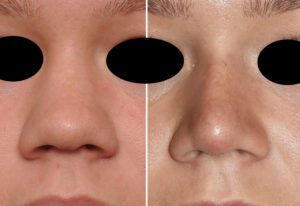Some noses show their most undesirable features from the frontal view from which one can see it the most. One of these aesthetic nasal deformities is the nose that is too wide or too fat. This ‘fatness’ could be isolated to just that the nasal tip being too wide or too round (bulbous) or could include the whole nose in which the bridge is also too wide. In short, the wide or broad nose may occur where the nasal skeleton joins the facial skeleton, between the nasal bones and upper lateral cartilages along the bridge, in the tip, and at the alar or lobular base of the nose.
The width of the nose needs to be in proportion to the height or projection of the nose and also to the width of the face. Imaginary lines (dorsal aesthetic lines) drawn down along the sides of the nose from the inside edge of the eyebrows should flow evenly down the bridge of the nose onto the nasal tip without interruption. While such measurements and assessment can be demonstrated on frontal photographs, most patients know when their nose is too wide.
There are a variety of rhinoplasty techniques for the wide nose. These can include some or all of the following; open approach, dorsal augmentation, nasal bone narrowing, spreader grafts, narrowing and refinement of the nasal tip, columellar strut graft, slight shortening and lifting of the nasal tip, and alar base wedge resection to narrow the lower nose. One of the keys to the wide nose is that augmentation is often needed to increase projection of both the nasal dorsum and the nasal tip.

While the nasal bridge may also be wide, one must be careful in narrowing the nasal bones by osteotomies in some cases. It is important to not disrupt the structural support of the nose so that the nasal passages do not become obstructed. For this reason, improvement of a wide bony bridge may be able to be done with cartilage graft augmentation alone which creates the illusion of a more narrow bridge. If the nasal bones need to be narrowed, this should be done carefully by gentle and careful inward repositioning of the nasal bones.
Making a nose more narrow through rhinoplasty will always improve how wide it appears. It is only a question of how much and does it meet the patient’s expectations. Also, most wide noses have thicker skin which will lead to more prolonged swelling from an open rhinoplasty approach. Patients will require some patience (months) before the full benefits of the rhinoplasty efforts may be realized.
Dr. Barry Eppley
Indianapolis, Indiana


